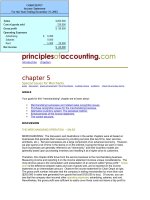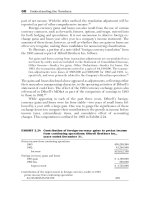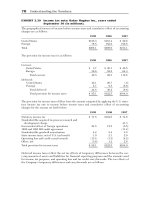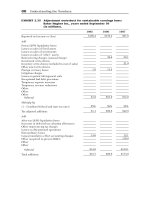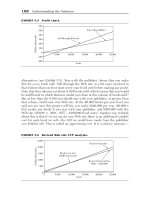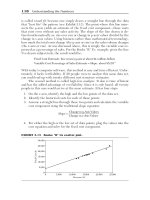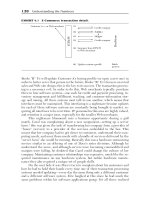Tiếng anh chuyên nghành kết toán kiểm toán - Phần 9 pps
Bạn đang xem bản rút gọn của tài liệu. Xem và tải ngay bản đầy đủ của tài liệu tại đây (463.11 KB, 16 trang )
introduction chapters
chapter 9
Long-term Investments
goals discussion goals achievement ll in the blanks multiple choice problems check list and key terms
GOALS
Your goals for this "long-term investments" chapter are to learn about:
• How intent influences the accounting for investments.
• The correct accounting for "available for sale" securities.
• Accounting for securities that are to be "held to maturity."
• Special accounting for certain long-term equity investments that require use of the equity
method.
• Special accounting for certain long-term equity investments that require consolidation.
DISCUSSION
INTENT-BASED ACCOUNTING
INTENT-BASED ACCOUNTING: In an earlier chapter you learned about accounting for "trading
securities." Recall that trading securities are investments that were made with the intent of
reselling them in the very near future, hopefully at a profit. Such investments are considered
highly liquid and are classified on the balance sheet as current assets. They are carried at fair
market value, and the changes in value are measured and included in the operating income of
each period.
However, not all investments are made with the goal of turning a quick profit. Many investments
are acquired with the intent of holding them for an extended period of time. The appropriate
accounting methodology depends on obtaining a deeper understanding of the nature/intent of the
particular investment. You have already seen the accounting for "trading securities" where the
intent was near future resale for profit. But, many investments are acquired with longer-term
goals in mind.
For example, one company may acquire a majority (more than 50%) of the stock of another. In
this case, the acquirer (known as the parent) must consolidate the accounts of the subsidiary. At
the end of this chapter we will briefly illustrate the accounting for such "control" scenarios.
Sometimes, one company may acquire a substantial amount of the stock of another without
obtaining control. This situation generally arises when the ownership level rises above 20%, but
stays below the 50% level that will trigger consolidation. In these cases, the investor is deemed
to have the ability to significantly influence the investee company. Accounting rules specify the
"equity method" of accounting for such investments. This, too, will be illustrated within this
chapter.
Not all investments are in stock. Sometimes a company may invest in a "bond" (you have no
doubt heard the term "stocks and bonds"). A bond payable is a mere "promise" (i.e., bond) to
"pay" (i.e., payable). Thus, the issuer of a bond payable receives money today from an investor
in exchange for the issuer's promise to repay the money in the future (as you would expect,
repayments will include not only amounts borrowed, but will also have added interest). In a later
chapter, we will have a detailed look at Bonds Payable from the issuer's perspective. In this
chapter, we will undertake a preliminary examination of bonds from the investor's perspective.
Although investors may acquire bonds for "trading purposes," they are more apt to be obtained
for the long-pull. In the latter case, the bond investment would be said to be acquired with the
intent of holding it to maturity (its final payment date) thus, earning the name "held-to-maturity"
investments. Held-to-maturity investments are afforded a special treatment, which is generally
known as the amortized cost approach.
By default, the final category for an investment is known as the "available for sale" category.
When an investment is not trading, not held-to-maturity, not involving consolidation, and not
involving the equity method, by default, it is considered to be an "available for sale" investment.
Even though this is a default category, do not assume it to be unimportant. Massive amounts of
investments are so classified within typical corporate accounting records. We will begin our look
at long-term investments by examining this important category of investments.
The following table recaps the methods you should be familiar with by the conclusion of this
chapter:
THE FAIR VALUE MEASUREMENT OPTION: The Financial Accounting Standards Board
recently issued a new standard, "The Fair Value Option for Financial Assets and Financial
Liabilities." Companies may now elect to measure certain financial assets at fair value.
This new ruling essentially allows many "available for sale" and "held to maturity"
investments to instead be measured at fair value (with unrealized gains and losses
reported in earnings), similar to the approach previously limited to trading securities. It is
difficult to predict how many companies will select this new accounting option, but it is
indicative of a continuing evolution toward valued-based accounting in lieu of traditional
historical cost-based approaches.
AVAILABLE FOR SALE SECURITIES
SIMILAR TO TRADING SECURITIES: The accounting for "available for sale" securities
will look quite similar to the accounting for trading securities. In both cases, the
investment asset account will be reflected at fair value. If you do not recall the accounting
for trading securities, it may be helpful to review that material via the indicated link.
To be sure, there is one big difference between the accounting for trading securities and
available-for-sale securities. This difference pertains to the recognition of the changes in value.
For trading securities, the changes in value were recorded in operating income. However, such is
not the case for available-for-sale securities. Here, the changes in value go into a special
account. We will call this account Unrealized Gain/Loss- OCI, where "OCI" will represent "Other
Comprehensive Income."
OTHER COMPREHENSIVE INCOME: This notion of other comprehensive income is somewhat
unique and requires special discussion at this time. There is a long history of accounting
evolution that explains how the accounting rule makers eventually came to develop the concept
of OCI. To make a long story short, most transactions and events make their way through the
income statement. As a result, it can be said that the income statement is "all-inclusive." Once
upon a time, this was not the case; only operational items were included in the income
statement. Nonrecurring or nonoperating related transactions and events were charged or
credited directly to equity, bypassing the income statement entirely (a "current operating" concept
of income).
Importantly, you must take note that the accounting profession now embraces the all-inclusive
approach to measuring income. In fact, a deeper study of accounting will reveal that the income
statement structure can grow in complexity to capture various types of unique transactions and
events (e.g., extraordinary gains and losses, etc.) but, the income statement does capture
those transactions and events, however odd they may appear.
There are a few areas where accounting rules have evolved to provide for special
circumstances/"exceptions." And, OCI is intended to capture those exceptions. One exception is
the Unrealized Gain/Loss - OCI on available-for-sale securities. As you will soon see, the
changes in value on such securities are recognized, not in operating income as with trading
securities, but instead in this unique account. The OCI gain/loss is generally charged or credited
directly to an equity account (Accumulated OCI), thereby bypassing the income statement ( there
are a variety of reporting options for OCI, and the most popular is described here).
AN ILLUSTRATION: Let us amend the Chapter 6 trading securities illustration such that the
investments were more appropriately classified as available for sale securities:
Assume that Webster Company acquired an investment in Merriam Corporation. The intent was
not for trading purposes, control, or to exert significant influence. The following entry was needed
on March 3, 20X6, the day Webster bought stock of Merriam:
3-3-X6
Available for Sale Securities
50,000
Cash
50,000
To record the purchase of 5,000 shares of
Merriam stock at $10 per share
Next, assume that financial statements were being prepared on March 31. By that date,
Merriam's stock declined to $9 per share. Accounting rules require that the investment "be
written down" to current value, with a corresponding charge against OCI. The charge is recorded
as follows:
3-31-X6
Unrealized Gain/Loss - OCI
5,000
Available for Sale Securities
5,000
To record a $1 per share decrease in the
value of 5,000 shares of Merriam stock
This charge against OCI will reduce stockholders' equity (the balance sheet remains in balance
with both assets and equity being decreased by like amounts). But, net income is not reduced,
as there is no charge to a "normal" income statement account. The rationale here, whether you
agree or disagree, is that the net income is not affected by temporary fluctuations in market value
since the intent is to hold the investment for a longer term period.
During April, the stock of Merriam bounced up $3 per share to $12. Webster now needs to
prepare this adjustment:
4-30-X6
Available for Sale Securities
15,000
Unrealized Gain/Loss - OCI
15,000
To record a $3 per share increase in the
value of 5,000 shares of Merriam stock
Notice that the three journal entries now have the available for sale securities valued at $60,000
($50,000 - $5,000 + $15,000). This is equal to their market value ($12 X 5,000 = $60,000). The
OCI has been adjusted for a total of $10,000 credit ($5,000 debit and $15,000 credit). This
cumulative credit corresponds to the total increase in value of the original $50,000 investment.
The preceding illustration assumed a single investment. However, the treatment would be the
same even if the available for sale securities consisted of a portfolio of many investments. That
is, each and every investment would be adjusted to fair value.
ALTERNATIVE A VALUATION ADJUSTMENTS ACCOUNT: As an alternative to directly
adjusting the Available for Sale Securities account, some companies may maintain a separate
Valuation Adjustments account that is added to or subtracted from the Available for Sale
Securities account. The results are the same; the reasons for using the alternative approach is to
provide additional information that may be needed for more complex accounting and tax
purposes. This coverage is best reserved for more advanced courses.
DIVIDENDS AND INTEREST: Dividends or interest received on available for sale securities is
reported as income and included in the income statement:
9-15-X5
Cash
75
Dividend Income
75
To record receipt of dividend on available
for sale security investment
THE BALANCE SHEET APPEARANCE: The above discussion would produce the following
balance sheet presentation of available for sale securities at March 31 and April 30. To aid the
illustration, all accounts are held constant during the month of April, with the exception of those
that change because of the fluctuation in value of Merriam's stock.
In reviewing this illustration, note that Available for Sale Securities are customarily classified in the
Long-term Investments section of the balance sheet. And, take note the the OCI adjustment is
merely appended to stockholders' equity.
HELD TO MATURITY SECURITIES
INVESTMENTS IN BONDS: It was noted earlier that certain types of financial instruments have a
fixed maturity date; the most typical of such instruments are "bonds." The held to maturity
securities are to be accounted for by the amortized cost method.
To elaborate, if you or I wish to borrow money we would typically approach a bank or other lender
and they would likely be able to accommodate our request. But, a corporate giant's credit needs
may exceed the lending capacity of any single bank or lender. Therefore, the large corporate
borrower may instead issue "bonds," thereby splitting a large loan into many small units. For
example, a bond issuer may borrow $500,000,000 by issuing 500,000 individual bonds with a
face amount of $1,000 each (500,000 X $1,000 = $500,000,000). If you or I wished to loan some
money to that corporate giant, we could do so by simply buying ("investing in") one or more of
their bonds.
The specifics of bonds will be covered in much greater detail in a subsequent chapter, where we
will look at a full range of issues from the perspective of the issuer (i.e., borrower). However, for
now we are only going to consider bonds from the investor perspective. You need to
understand just a few basics: (1) each bond will have an associated "face value"
(e.g., $1,000) that corresponds to the amount of principal to be paid at maturity, (2)
each bond will have a contract or stated interest rate (e.g., 5% meaning that the bond pays
interest each year equal to 5% of the face amount), and (3) each bond will have a term (e.g., 10
years meaning the bonds mature 10 years from the designated issue date). In other words, a
$1,000, 5%, 10-year bond would pay $50 per year for 10 years (as interest), and then pay $1,000
at the stated maturity date 10 years after the original date of the bond.
THE ISSUE PRICE: How much would you pay for the above 5%, 10-year bond: Exactly $1,000,
more than $1,000, or less than $1,000? The answer to this question depends on many factors,
including the credit-worthiness of the issuer, the remaining time to maturity, and the overall market
conditions. If the "going rate" of interest for other bonds was 8%, you would likely avoid this 5%
bond (or, only buy it if it were issued at a deep discount). On the other hand, the 5% rate might
look pretty good if the "going rate" was 3% for other similar bonds (in which case you might
actually pay a premium to get the bond). So, bonds might have an issue price that is at their face
value (also known as "par"), or above (at a premium) or below (at a discount) face. The price of a
bond is typically stated as percentage of face; for example 103 would mean 103% of face, or
$1,030. The specific calculations that are used to determine the price one would pay for a
particular bond are revealed in a subsequent chapter.
RECORDING THE INITIAL INVESTMENT: An Investment in Bonds account (at the purchase
price plus brokerage fees and other incidental acquisition costs) is established at the time of
purchase. Importantly, premiums and discounts are not recorded in separate accounts:
ILLUSTRATION OF BONDS PURCHASED AT PAR:
1-1-X3
Investment in Bonds
5,000
Cash
5,000
To record the purchase of five $1,000,
5%, 3-year bonds at par interest
payable semiannually
The above entry reflects a bond purchase as described, while the following entry reflects the
correct accounting for the receipt of the first interest payment after 6 months.
6-30-X3
Cash
125
Interest Income
125
To record the receipt of an interest
payment ($5,000 par X .05 interest X 6/12
months)
Now, the entry that is recorded on June 30 would be repeated with each subsequent interest
payment continuing through the final interest payment on December 31, 20X5. In addition, at
maturity, when the bond principal is repaid, the investor would make this final accounting entry:
12-31-X5
Cash
5,000
Investment in Bonds
5,000
To record the redemption of bond
investment at maturity
ILLUSTRATION OF BONDS PURCHASED AT A PREMIUM: When bonds are purchased at a
premium, the investor pays more than the face value up front. However, the bond's maturity
value is unchanged; thus, the amount due at maturity is less than the initial issue price! This may
seem unfair, but consider that the investor is likely generating higher annual interest receipts than
on other available bonds that is why the premium was paid to begin with. So, it all sort of
comes out even in the end. Assume the same facts as for the above bond illustration, but this
time imagine that the market rate of interest was something less than 5%. Now, the 5% bonds
would be very attractive, and entice investors to pay a premium:
1-1-X3
Investment in Bonds
5,300
Cash
5,300
To record the purchase of five $1,000,
5%, 3-year bonds at 106 interest
payable semiannually
The above entry assumes the investor paid 106% of par ($5,000 X 106% = $5,300). However,
remember that only $5,000 will be repaid at maturity. Thus, the investor will be "out" $300 over
the life of the bond. Thus, accrual accounting dictates that this $300 "cost" be amortized
("recognized over the life of the bond") as a reduction of the interest income:
6-30-X3
Cash
125
Interest Income
75
Investment in Bonds
50
To record the receipt of an interest
payment ($5,000 par X .05 interest X 6/12
months = $125; $300 premium X 6
months/36 months = $50 amortization)
The preceding entry is undoubtedly one of the more confusing entries in accounting, and bears
additional explanation. Even though $125 was received, only $75 is being recorded as interest
income. The other $50 is treated as a return of the initial investment; it corresponds to the
premium amortization ($300 premium allocated evenly over the life of the bond $300 X (6
months/36 months)) and is credited against the Investment in Bonds account. This process of
premium amortization (and the above entry) would be repeated with each interest payment date.
Therefore, after three years, the Investment in Bonds account would be reduced to $5,000
($5,300 - ($50 amortization X 6 semiannual interest recordings)). This method of tracking
amortized cost is called the straight-line method. There is another conceptually superior
approach to amortization, called the effective-interest method, that will be revealed in later
chapters. However, it is a bit more complex and the straight-line method
presented here is acceptable so long as its results are not materially
different than would result under the effective-interest method.
In addition, at maturity, when the bond principal is repaid, the investor
would make this final accounting entry:
12-31-X5
Cash
5,000
Investment in Bonds
5,000
To record the redemption of bond
investment at maturity
In an attempt to make sense of the above, perhaps it is helpful to reflect on just the "cash out"
and the "cash in." How much cash did the investor pay out? It was $5,300; the amount of the
initial investment. How much cash did the investor get back? It was $5,750; $125 every 6
months for 3 years and $5,000 at maturity. What is the difference? It is $450 ($5,750 - $5,300)
which is equal to the income recognized above ($75 every 6 months, for 3 years). At its very
essence, accounting measures the change in money as income. Bond accounting is no
exception, although it is sometimes illusive to see. The following "amortization" table reveals
certain facts about the bond investment accounting, and is worth studying to be sure you
understand each amount in the table. Be sure to "tie" the amounts in the table to the entries
above:
Sometimes, complex topics like this are easier to understand when you think about the balance
sheet impact of a transaction. For example, on 12-31-X4, Cash is increased $125, but the
Investment in Bond account is decreased by $50 (dropping from $5,150 to $5,100). Thus, total
assets increased by a net of $75. The balance sheet remains in balance because the
corresponding $75 of interest income causes a corresponding increase in retained earnings.
ILLUSTRATION OF BONDS PURCHASED AT A DISCOUNT: The discount scenario is very
similar to the premium scenario, but "in reverse." When bonds are purchased at a discount, the
investor pays less than the face value up front. However, the bond's maturity value is unchanged;
thus, the amount due at maturity is more than the initial issue price! This may seem like a
bargain, but consider that the investor is likely getting lower annual interest receipts than is
available on other bonds that is why the discount existed in the first place. Assume the same
facts as for the previous bond illustration, except imagine that the market rate of interest was
something more than 5%. Now, the 5% bonds would not be very attractive, and investors would
only be willing to buy them at a discount:
1-1-X3
Investment in Bonds
4,850
Cash
4,850
To record the purchase of five $1,000,
5%, 3-year bonds at 97 interest payable
semiannually
The above entry assumes the investor paid 97% of par ($5,000 X 97% = $4,850). However,
remember that a full $5,000 will be repaid at maturity. Thus, the investor will get an additional
$150 over the life of the bond. Accrual accounting dictates that this $150 "benefit" be recognized
over the life of the bond as an increase in interest income:
6-30-X3
Cash
125
Investment in Bonds
25
Interest Income
150
To record the receipt of an interest
payment ($5,000 par X .05 interest X
6/12 months = $125; $150 discount X 6
months/36 months = $25 amortization)
The preceding entry would be repeated at each interest payment date. Again, further
explanation may prove helpful. In addition to the $125 received, another $25 of interest income is
recorded. The other $25 is added to the Investment in Bonds account; as it corresponds to the
discount amortization ($150 discount allocated evenly over the life of the bond $150 X (6
months/36 months)). This process of discount amortization would be repeated with each interest
payment. Therefore, after three years, the Investment in Bonds account would be increased to
$5,000 ($4,850 + ($25 amortization X 6 semiannual interest recordings)). This is another
example of the straight-line method of amortization since the amount of interest is the same each
period.
When the bond principal is repaid at maturity, the investor would also make this final accounting
entry:
12-31-X5
Cash
5,000
Investment in Bonds
5,000
To record the redemption of bond
investment at maturity
Let's consider the "cash out" and the "cash in." How much cash did the
investor pay out? It was $4,850; the amount of the initial investment.
How much cash did the investor get back? It is the same as it was in
the preceding illustration $5,750; $125 every 6 months for 3 years and
$5,000 at maturity. What is the difference? It is $900 ($5,750 - $4,850)
which is equal to the income recognized above ($150 every 6 months,
for 3 years). Be sure to "tie" the amounts in the following amortization
table to the related entries:
Can you picture the balance sheet impact on 6-30-X5? Cash increased by $125, and the
Investment in Bond account increased $25. Thus, total assets increased by $150. The balance
sheet remains in balance because the corresponding $150 of interest income causes a
corresponding increase in retained earnings.
THE EQUITY METHOD OF ACCOUNTING
THE EQUITY METHOD: On occasion, an investor may acquire enough ownership in the stock of
another company to permit the exercise of "significant influence" over the investee company. For
example, the investor has some direction over corporate policy, and can sway the election of the
board of directors and other matters of corporate governance and decision making. Generally,
this is deemed to occur when one company owns more than 20% of the stock of the other
although the ultimate decision about the existence of "significant influence" remains a matter of
judgment based on an assessment of all facts and circumstances. Once significant influence is
present, generally accepted accounting principles require that the investment be accounted for
under the "equity method" (rather than the methods previously discussed, such as those
applicable to trading securities or available for sale securities).
With the equity method, the accounting for an investment is set to track the "equity" of the
investee. That is, when the investee makes money (and experiences a corresponding increase in
equity), the investor will similarly record its share of that profit (and vice-versa for a loss). The
initial accounting commences by recording the investment at cost:
4-1-X3
Investment
50,000
Cash
50,000
To record the purchase of 5,000 shares of
Legg stock at $10 per share. Legg has
20,000 shares outstanding, and the
investment in 25% of Legg (5,000/20,000
= 25%) is sufficient to give the investor
significant influence
Next, assume that Legg reports income for the three-month period ending June 30, 20X3, in the
amount of $10,000. The investor would simultaneously record its "share" of this reported income
as follows:
6-30-X3
Investment
2,500
Investment Income
2,500
To record investor's share of Legg's
reported income (25% X $10,000)
Importantly, this entry causes the Investment account to increase by the investor's share of the
investee's increase in its own equity (i.e., Legg's equity increased $10,000, and the entry causes
the investor's Investment account to increase by $2,500), thus the name "equity method." Notice,
too, that the credit causes the investor to recognize income of $2,500, again corresponding to its
share of Legg's reported income for the period. Of course, a loss would be reported in just the
opposite fashion.
When Legg pays out dividends (and decreases its equity), the investor will need to reduce its
Investment account:
7-01-X3
Cash
1,000
Investment
1,000
To record the receipt of $1,000 in
dividends from Legg Legg declared and
paid a total of $4,000 ($4,000 X 25% =
$1,000)
The above entry is based on the assumption that Legg declared and paid a $4,000 dividend on
July 1. This treats dividends as a return of the investment (not income, because the income is
recorded as it is earned rather than when distributed). In the case of dividends, notice that the
investee's equity reduction is met with a corresponding proportionate reduction of the
Investment account on the books of the investor.
Note that market-value adjustments are usually not utilized when the equity method is
employed. Essentially, the Investment account tracks the equity of the investee, increasing as
the investee reports income and decreasing as the investee distributes dividends.
INVESTMENTS REQUIRING CONSOLIDATION
CONCEPT OF CONTROL: You only need to casually review the pages of most any business
press before you will notice a story about one business buying another. Such acquisitions are
common and number in the thousands annually. Typically, such transactions are effected rather
simply, by the acquirer simply buying a majority of the stock of the target company. This majority
position enables the purchaser to exercise control over the other company; electing a majority of
the board of directors, which in turn sets the direction for the company. Control is ordinarily
established once ownership jumps over the 50% mark, but management contracts and other
similar arrangements may allow control to occur at other levels.
ECONOMIC ENTITY CONCEPT AND CONTROL: The acquired company may continue to
operate, and maintain its own legal existence. In other words, assume Premier Tools Company
bought 100% of the stock of Sledge Hammer Company. Sledge (now a "subsidiary" of Premier
the "parent") will continue to operate and maintain its own legal existence. It will merely be under
new ownership. But, even though it is a separate legal entity, it is viewed by accountants as part
of a larger "economic entity." The intertwining of ownership means that Parent and Sub are "one"
as it relates to economic performance and outcomes. Therefore, accounting rules require that
parent companies "consolidate" their financial reports, and include all the assets, liabilities, and
operating results of all controlled subsidiaries. When you look at the financial statements of a
conglomerate like General Electric, what you are actually seeing is the consolidated picture of
many separate companies owned by GE.
ACCOUNTING ISSUES: Although the processes of consolidation can become quite complex (at
many universities, an entire course may be devoted to this subject alone), the basic principles are
straightforward. Assume that Premier's "separate" (before consolidating) balance sheet,
immediately after purchasing 100% of Sledge's stock, appeared as follows:
Notice the highlighted Investment in Sledge account above, indicating that Premier paid $400,000
for the stock of Sledge. Do take note that the $400,000 was not paid to Sledge; it was paid to the
former owners of Sledge. Sledge merely has a new owner, but it is otherwise "unchanged" by the
acquisition. Assume Sledge's separate balance sheet looks like this:
Let's examine carefully what Premier got for its $400,000 investment. Premier
became the sole owner of Sledge, which has assets that are reported on
Sledge's books at $450,000, and liabilities that are reported at $150,000. The
resulting net book value ($450,000 - $150,000 = $300,000) is reflected as
Sledge's total stockholders' equity. Now, you notice that Premier paid $100,000 in excess of book
value for Sledge ($400,000 - $300,000). This excess is quite common, and is often called
"purchase differential" (the difference between the price paid for another company, and the net
book value of its assets and liabilities). Why would Premier pay such a premium? Remember
that assets and liabilities are not necessarily reported at fair value. For example, the land held by
Sledge is reported at its cost, and its current value may differ (let's assume Sledge's land is really
worth $110,000, or $35,000 more than its carrying value of $75,000). That would explain part of
the purchase differential. Let us assume that all other identifiable assets and liabilities are carried
at their fair values. But what about the other $65,000 of purchase differential ($100,000 total
differential minus the $35,000 attributable to specifically identified assets or liabilities)?
GOODWILL: Whenever one business buys another, and pays more than the fair value of all the
identifiable pieces, the excess is termed "goodwill." This has always struck me as an odd term
but I suppose it is easier to attach this odd name, in lieu of using a more descriptive account title
like: Excess of Purchase Price Over Fair Value of Identifiable Assets Acquired in a Purchase
Business Combination. So, when you see Goodwill in the corporate accounts, you now know
what it means. It only arises from the purchase of one business by another. Many companies
may have implicit goodwill, but it is not recorded until it arises from an actual acquisition (that is, it
is bought and paid for in a arm's-length transaction).
Perhaps we should consider why someone would be willing to pay such a premium. There are
many possible scenarios, but suffice it to say that many businesses are worth more than than
their identifiable pieces. A movie rental store, with its business location and established customer
base, is perhaps worth more than the movies, display equipment, and check-out stands it holds.
A law firm is hopefully worth more than its desks, books, and computers. An oil company is likely
far more valuable than its drilling and pumping gear. Consider the value of a brand name that
may not be on the books but has instead been established by years of marketing. And, let's not
forget that a business combination may eliminate some amount of competition; some businesses
will pay a lot to be rid of a competitor.
THE CONSOLIDATED BALANCE SHEET: No matter how goodwill arises, the accountant's
challenge is to measure and report it in the consolidated statements along with all the other
assets and liabilities of the parent and sub. Study the following consolidated balance sheet for
Premier and Sledge, clicking on the account title links to see how the related dollar amounts are
calculated:
Premier Tools Company and Consolidated Subsidiaries
Balance Sheet
March 31, 20X3
Assets
Liabilities
Current Assets
Current Liabilities
Cash
$150,000
Accounts payable $160,000
Trading securities
70,000
Salaries payable 30,000
Accounts receivable
110,000
Interest payable 10,000
$200,000
Inventories
220,000 $550,000
Long-term Liabilities
Property, Plant & Equip.
Note payable
$240,000
Land $135,000
Mortgage liability
110,000 350,000
Building and equipment
(net)
375,000 510,000
Total liabilities
$550,000
Intangible Assets
Stockholders' equity
Patent
$225,000
Capital stock $300,000
Goodwill
65,000 290,000
Retained earnings 500,000
Total stockholders' equity
800,000
Total assets
$1,350,000
Total Liabilities and
equity
$1,350,000
In the above illustration, take note of several important points. First, the Investment in Sledge
account is absent because it has effectively been replaced with the individual assets and liabilities
of Sledge. Second, the assets acquired from Sledge, including goodwill, have been pulled into
the consolidated balance sheet at the price paid for them (for example, take special note of the
calculations relating to the Land account). Finally, note the consolidated stockholders' equity
amounts are the same as from Premier's separate balance sheet. This result is expected since
Premier's separate accounts include the ownership of Sledge via the Investment in Sledge
account (which has now been replaced by the actual assets and liabilities of Sledge).
It may appear a bit mysterious as to how the above balance sheet "balances" there is an
orderly worksheet process that can be shown to explain how this consolidated balance sheet
comes together, and that is best reserved for advanced accounting classes for now simply
understand that the consolidated balance sheet encompasses the assets (excluding the
investment account), liabilities, and equity of the parent at their dollar amounts reflected on the
parent's books, along with the assets (including goodwill) and liabilities of the sub adjusted to their
values based on the price paid by the parent for its ownership in the sub.
THE CONSOLIDATED INCOME STATEMENT: Although it will not be illustrated here, it is
important to know that the income statements of the parent and sub will be consolidated post-
acquisition. That is, in future months, quarters, and years, the consolidated income statement will
reflect the revenues and expenses of both the parent and sub added together. This process is
ordinarily straightforward. But, an occasional wrinkle will arise. For instance, if the parent paid a
premium in the acquisition for depreciable assets and/or inventory, the amount of consolidated
depreciation expense and/or cost of goods sold may need to be tweaked to reflect alternative
amounts from those reported in the separate statements. And, if the parent and sub have done
business with one another, adjustments will be needed to avoid reporting intercompany
transactions. We never want to report internal transactions between affiliates as actual sales. To
do so can easily and rather obviously open the door to manipulated financial results.
